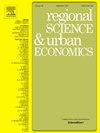Work-from-home and cities: An elementary spatial model
IF 2.9
2区 经济学
Q1 ECONOMICS
引用次数: 0
Abstract
This paper analyzes the urban impacts of hybrid WFH in the simplest possible model, relying on Leontief utility and production functions and other simplifying assumptions. The analysis shows that introduction of WFH raises both the wage and household land consumption (raising worker utility) while shrinking the size of the business district and reducing business land rent. When WFH requires home work space, the city’s overall spatial size increases, with residential rents rising in the suburbs while falling near the center. The decline in business rent and the rotation of the residential rent contour match empirical evidence showing that WFH reduces office-building values and flattens the residential rent gradient.
居家办公与城市:一个基本的空间模型
本文基于Leontief效用和生产函数等简化假设,在尽可能简单的模型下分析混合水水对城市的影响。分析结果表明,引入WFH不仅提高了工资水平,还提高了家庭土地消费(提高了劳动者的效用),同时还缩小了商圈面积,降低了企业土地租金。当WFH需要家庭工作空间时,城市的整体空间规模增加,郊区的住宅租金上涨,而中心附近的住宅租金下降。商业租金的下降和住宅租金等高线的旋转与实证证据相吻合,表明WFH降低了办公楼价值,使住宅租金梯度趋于平缓。
本文章由计算机程序翻译,如有差异,请以英文原文为准。
求助全文
约1分钟内获得全文
求助全文
来源期刊

Regional Science and Urban Economics
Multiple-
CiteScore
5.30
自引率
9.70%
发文量
63
期刊介绍:
Regional Science and Urban Economics facilitates and encourages high-quality scholarship on important issues in regional and urban economics. It publishes significant contributions that are theoretical or empirical, positive or normative. It solicits original papers with a spatial dimension that can be of interest to economists. Empirical papers studying causal mechanisms are expected to propose a convincing identification strategy.
 求助内容:
求助内容: 应助结果提醒方式:
应助结果提醒方式:


